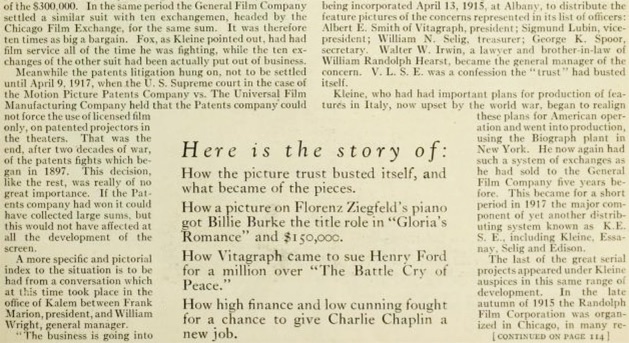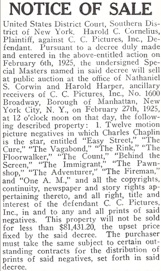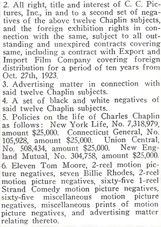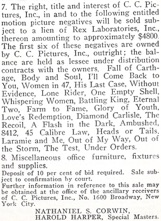One A. M. Clippings 49/56
Terry Ramsaye, Photoplay, New York, November 1924.
NOTICE OF SALE
United States District Court, Southern District of New York,
Harold C. Cornelius, Plaintiff, against C. C. Pictures,
Inc., Defendant. Pursuant to a decree duly made and entered
in the above-entitled action on February 6th, 1925,
the undersigned Special Masters named in said decree will
sell at public auction at the office of Nathaniel S.
Corvin and Harold Harper, ancillary receivers of C. C. Pictures,
Inc., No. 1600 Broadway, Borough of Manhattan,
New York City, N. Y., on February 27th, 1925, at 12 o‘clock noon
on that day, the following described property: 1. Twelve
motion picture negatives in which Charles Chaplin is the star,
entitled „Easy Street,“ „The Cure,“ „The Vagabond,“
„The Rink,“ „The Floorwalker,“ „The Count,“ 2Behind the Screen,“
„The Immigrant,“ „The Pawnshop,“ „The Adventurer,“
„The Fireman“ and „One A. M.,“ and all the copyrights, continuity,
newspaper and story rights appertaining thereto, and
all right, title and interest of the defendant C. C. Pictures, Inc.,
in and to any and all prints of said negatives. This
property will not be sold for less than $81,431,20, the upset
price fixed by the said decree. The purchaser must
take the same subject to certain outstanding contracts for the
distribution of prints of said negatives, set forth
in said decree. (...)
NATHANIEL S. CORWIN,
HAROLD HARPER, Special Masters.
(...) Exhibitors Herald, Feb. 21 and 28, 1925
„The picture was a curiosity but not a box office success“
Editorial content. „The Romantic History of the Motion Picture“
In a box: „Chaplin Revelations!
A new and deeply inside view of the most important
period of Charles Chaplin‘s screen career
is here revealed for the first time. Its striking interest
comes from the inside which it gives concerning
the whole star-making process and the steps of which fame
is built. Although Mr. Ramsaye keeps himself
out of his own writings, it should be added that he was
a confidential assistant to John R. Freuler
through the period concerned and a party to some
of the remarkable operations never told before.
Read here how a wistful waif of the London tenements
came into his kingdom.
James R. Quirk“
„By Terry Ramsaye
Chapter XXXII
IN the days of 1915-16 the overlords of the motion
picture industry were just beginning to learn how
to cover the linen of the luncheon table with giant arithmetic.“ (...)
First photo, page 66: „Charlie Chaplin
and John Freuler, president of the Mutual Film
Company. In 1916, Freuler paid Chaplin
the record-smashing salary of $10,000 a week.“ (...)
Contents, page 67: „Here is
the story of:“ (...) „How high finance and
low cunning fought for a chance
to give Charlie Chaplin a new job.“ (...)
Text, page 116-122: „The real sensation of the season
of 1915-16 was yet to come. Charlie Chaplin was
now the biggest single fact of the screen. He was yet with the
Essanay Company, working at the California studios.
The Essanay-Chaplin pictures were tremendously successful,
attaining wide circulation.“ (...)
„The result of this was to give Chaplin the greatest
screen showing in the history of the art. No one,
not even Mary Pickford in the days of her Biograph one-reelers,
had been so often and so constantly on the screen.“ (...)
„Chaplin alone played with the same picture to all classes
and all screens. His comedies were short enough and
good enough to appear with a Pickford feature in the best
theatre. At the same time Chaplin was so primary
in the appeals of his comedy that his pictures also ran as screen
mates to the Broncho Billy cowboy-shoot‘em-dead saloon
dramas in the nickel shows.“ (...)
„The situation outside and the Chaplin hunger within
the Mutual Film Corporation created the situation
which rocketed Chaplin into a yet greater fame and development
which both broke and made screen precedents with far
reaching effects.“ (...)
„Chaplin and Freuler came to an agreement one
Wednesday night in February, 1916, at the close
of a conversational session on the mezzanine floor of the
Astor Hotel.“
„In spite of the violent opposition of the New York office
Chaplin insisted on an experimental production entitled
One A. M. in which he carried through the amazing feat of
playing two reels entirely alone. The only other
member of the cast was a taxi driver on the screen for one
moment delivering the inebriate hero at his front door
at 1 o‘clock in the morning. The picture was a curiosity but
not a box office success.“
Redaktioneller Inhalt




